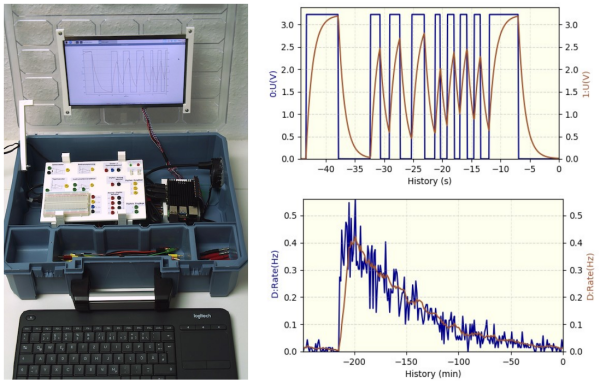



The PhyPiDAQ project aims to provide students access to state-of-the-art measurement technology and data acquisition tools. As it is based on standardized protocols and hardware, it can not only be cheaper to set up than similar offers, but also gives a great educational introduction in methods of modern science. Additionally, the measuring technology can be run off a power bank, making it portable and allowing great experiments in nature. This project targets students from middle school up to undergraduates at the university level with great matching educational concepts. Looking beyond school it is also a good base for STEM based competitions or science fairs.
The figure above shows on the left the measuring case with Raspberry Pi, the front face of the circuit board with 2 mm connectors, the TFT display and the keyboard. On the top right is shown the voltage over a capacitor driven by a sqare wave, measured with an ADS 1115 analog-to-digital converter. On the bottom right you see the gamma-ray rate from Radon decay products measured with a GDK 101 sensor. Note that the experiments can also be performed without the mearuring case by assembling the components on separate bread boards connected to the Rasprerry Pi.
Detailed descriptions of the software, hardware guides and build instructions or of educational concepts are available in the repositories of the PhyPiDAQ project.
The necessary steps to install PhyPiDAQ on a Raspberry Pi are documented in this shell script. See full documentation for details.
Das PhyPiDAQ-Projekt zielt darauf ab, Studierenden und SchülerInnen Zugang zu moderner Messtechnik und Datenerfassung zu verschaffen. Da es auf offenen, standardisierten Protokollen und leicht verfügbarer Hardware basiert, kann es nicht nur kostengünstig eingerichtet werden, sondern bietet auch eine hervorragende pädagogische Möglichkeiten zur Einführung in die Messmethoden der modernen Wissenschaft. Die Messtechnik kann mit einer Powerbank betrieben werden, was sie tragbar macht und Experimente auch in freier Natur ermöglicht. PhyPiDAQ richtet sich an SchülerInnen von der Mittelstufe bis hin zu Studierenden auf Universitätsebene. Über die Schule hinaus ist es auch eine gute Basis für MINT-Wettbewerbe.
Die Abbildung oben zeigt links den Messkoffer mit Raspberry Pi, der Vorderseite der Platine mit 2-mm-Steckern, TFT-Display und Tastatur. Rechts oben ist der Spannungsverlauf an einem Kondensator bei Anlegen eines Rechtecksignals mit unregelmäßiger Frequenz gezeigt, gemessen mit einem ADS 1115 Analog-Digital-Wandler. Rechts unten sieht man die Gammastrahlungsrate von Radon-Zerfallsprodukten, gemessen mit einem GDK 101-Sensor. Die einzelnen Experimente des PhyPiDAQ-Projekts können auch ohne den Koffer auf an den Raspberry Pi angeschlossenen Breadbords aufgebaut werden.
Detaillierte Beschreibungen der empfohlenen Hardware, der Software sowie Bauanleitungen und Beschreibungen von Experimenten mit PhyPiDAQ finden Sie in den Repositories des PhyPiDAQ-Projekts.
Die zur Installation von PhyPiDAQ auf einem Raspberry Pi notwendigen Schritte befinden sich in diesem Shell Script. Weitere Details sind in der vollen Dokumentation zu finden.
For information on how to contribute to this project, please refer to the CONTRIBUTING.md file.
This project is licensed under the
MIT BSD 2-Clause License. For more information refer to the
LICENSE file.